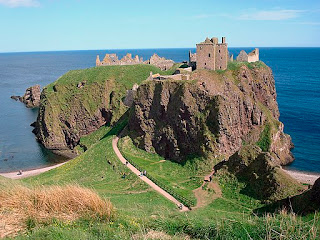Christian Fletcher rode fiercely along the cliffs of North-East Scotland near Stonehaven, looking behind her occasionally to make sure that she wasn't being followed. She guarded the precious cargo of the Honours of Scotland (the Scottish Crown Jewels) which she would throw into the sea if there was any danger of Cromwell getting his hands on them. It was 1652, and Cromwell and the New Model Army, furious about Charles II's coronation in Scotland, were anxious to destroy the Honours.
They had surrounded Dunottar Castle, where the Honours were hidden in sacks of wool for months, but Sir George Ogilvie, the lieutenant-governor of the castle refused. During the blockade by Cromwell's army, Elizabeth Doublas, his wife, and Christian Fletcher, the seemingly meek minister's wife formed a plan. They knew that the minister's wife would never be suspected. Helped by Anne Lindsay, who walked out of the castle first with the King's papers sewn into her clothes, and a maid, Christian Fletcher carefully smuggled the Honours out. According to one story by a tutor to the Earl Marischal, she lowered them to the beach below where her maid pretended to gather seaweed. However, she said in 1664 that it took her three trips, and she hid the jewels amongst sacks of goods.
She hid them at the foot of her bed first, but then managed to hide them under the pulpit at Kineff Kirk, where they remained for eight years. They were eventually found, to the country's great delight, in an oak chest at Edinburgh Castle. This was largely due to Sir Walter Scott's campaign to find the valuable jewels.
Fletcher was awarded 2000 marks by the Scottish government for her daring rescue of the jewels.





No comments:
Post a Comment